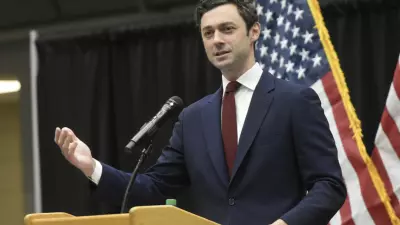Mark Yonkman is the founder of the newly created Super PAC Reclaim the Rural Vote and a rural vote messaging expert. Mark’s background straddles not only the rural and urban worlds but the black/white, gay/straight, and farm/professional worlds as well. Read more of his Rural Whisperer columns here.

Kamala Harris has energized the Democratic Party at all levels, and at this point, the election is hers to lose. I just attended our county convention and the Michigan Democratic Convention, and engagement and turnout is growing by leaps and bounds.
This growth, however, is all among the party faithful. Yet there is a middle that is eager to get on board. I hear over and over that “I’ll vote for any Democrat who is in the center.” And the Harris team has been making moves to get to the center.
A relatively tiny shift on EVs would send the right message, rebut the negative messaging on EVs that I see on Republican campaign websites, and, at the same time, be the right thing to do. That is a pivot to dual-fuel trucks and automobiles (meaning the poorly named plug-in hybrids), which results in getting 6 times as many electric vehicles on the road in the near term.
I had an interesting conversation with a farmer last week about EVs. His current Ford F-350 diesel has 350,000 miles on it – he will need to replace it soon. We were discussing how great it would be if Ford made a dual-fuel truck where electric motors drove one axle and a diesel drove the other. You would only need the diesel engine when you really needed the power because a small battery pack would be fine for daily driving in ordinary non-load conditions. I would like the same truck, especially as I could charge it directly from my solar panels – on a farm, I have unlimited space for solar panels.
He agreed and then said that, unfortunately, it will never happen because “Democrats and environmentalists won’t allow it.”
This was illuminating. He is both right and wrong at the same time. Kamala Harris can rectify this.
Indeed, despite being the most popular vehicle in America, and despite dual-fuel electrics having been around since 1899 and the first mass-produced vehicle launched in 2008, no one makes a dual-fuel pickup.
Let’s look at why he might have said that. And why Ford Motor, after losing $2.5 billion on all-electric vehicles, is pivoting to hybrid vehicles. And why General Motors, after committing to a 100% all-electric fleet, has now reversed course?
Environmentalists hate plug-in hybrids
Many purist environmentalists loathe and dismiss plug-in hybrids. And refuse to call them dual-fuel electrics. Some go so far as to say plug-in hybrids provide no environmental benefit because they assume drivers won’t actually plug them in. You end up with a gasoline car carrying around a separate drive train for no reason. Some go so far as to state that plug-ins cause more harm than they solve.
The following is what my neighbor is hearing about going 100% electric:
NPR reported that “in Europe, California, and a number of other states, policymakers [are] mandating that all new cars be zero-emission by 2035.”
The Transport and Environment think tank calls plug-in hybrids “A dangerous distraction, not a climate solution.” (By assuming drivers never plug them in).
Boris Johnson once declared that Britain would ban all gasoline, diesel, and hybrid cars beginning in 2035.
Senator Harris once had a climate plan that called for 100% of new cars to be zero-emission vehicles by 2035.
Due to pressure from environmentalists and its once U.S. Government shareholder, General Motors abandoned its very successful Chevrolet Volt (a plug-in hybrid introduced in 2010) and said it would sell only 100% electric vehicles by 2035.
I can see why my neighbor thinks that it is Democrats and Environmentalists who are holding us back from a greener future. There is a growing chorus of electric vehicle advocates who agree. Even Peter Coy at The New York Times has come around to the rural point of view.
Leverage this and pivot.
Environmentalists ignore scale and supply chain issues
Environmental impact comparisons should be based on the entire fleet and not on a vehicle-to-vehicle comparison. According to Toyota, to build a fleet of 6 vehicles with a set amount of minerals, a manufacturer can make:
1 full electric vehicle and 5 full gasoline vehicles, or
6 dual fuel vehicles (PHEVs)
Environmentalists refuse to acknowledge that the fleet of 6 vehicles consisting of 1 full electric with a huge battery and 5 other vehicles with internal combustion engines will pollute far more than the equivalent fleet of 6 plug-in hybrids, even if one or two of the plug-in vehicles owners never plugs them in. Nor do they acknowledge how easy it is to incent drivers to plug them in.
In addition, as Toyota points out, our supply chain issues for lithium and rare earth minerals will not be resolved in the short term. They will get worse.
Indeed, when I installed the battery pack in my house for my windmills and solar panels, a Tesla Power Wall was $7000. Today, four years later (and despite the 2023 crash in minerals prices), that cost is $10,000 today.
We should be using those scarce resources to get the most bang for the buck – which in the near term means plug-in hybrids. It is far better to get 6 dual-fuel electric vehicles on the road than a single all-electric vehicle. Sure, once we have adequate domestic production, let’s revisit this issue.
Environmentalists also ignore the needs of rural voters, battery replacement costs, and national defense issues
If I arrive home with a depleted battery and I get a call to a fire as a volunteer firefighter, I can’t respond. A dual-fuel vehicle addresses this issue.
If my child is hurt and I forgot to plug in my car, I can’t get my child to the ER. The closest ambulance is an hour round trip. A plug-in addresses this.
When my battery eventually fails over time, I can’t afford the $35,000 it costs to replace a large Tesla battery. I can’t even drive the vehicle to get the battery replaced. A dual fuel addresses this, and I probably can afford a battery that is 1/6th the cost.
If we are building all electrics and suddenly our supply chain for battery minerals is cut off, what do we do?
If I’m in Maui, just got home with a dead battery, and have a fire evacuation order, what do I do?
I also don’t need a Level II or Level III charger. I can use a standard 120v wall outlet (which is essentially trickle charging) because I don’t care how long it takes. Overnight would be a full charge, but if an emergency arises in the meantime, I can always rely on the gasoline drive train. (A full electric would take 3 days to charge this way).
Dual fuel electrics address all of these situations. And to a person, everyone I know in rural America always has 5 gallons or more of extra gas on hand – I can store the fuel I need for the gas side of my vehicle and instantly refuel the gas tank. That technology simply does not yet exist for an electric vehicle.
Unions love dual fuel electrics
A pivot to dual fuel electrics also allays union concerns. They are more complicated to make (but more resilient) and eliminate the union fear that all-electric vehicle manufacturing will eliminate union jobs. And dual fuel electrics are a terrific way to transition from ICE to electric vehicle manufacturing. Dual fuel manufacturing also preserves existing knowledge and skills in making more complicated internal combustion engines. From a national defense point of view, we want to preserve those skills.
The Harris administration should go all-in on dual-fuel vehicles
Kamala Harris is uniquely positioned to usher in a pivot to dual-fuel electrics. She simply is not shackled by the need for donor dollars at this time. She instead can focus on voters and doing the right thing, and voters would be reassured by this. Just as Ford and GM have experienced.
She (or Walz) needs to actually say something like, “The Internal Combustion Engine is not going away on my watch. Instead, I will do everything possible to enable all Americans to use their electric drive trains as much as possible. This can only be accomplished by an immediate focus on dual fuel vehicles.” She will be viewed as leading her base rather than following it.
At the end of the day, we will get 6 times as many electrics on the road. These electrics will simply have a backup gasoline engine on board that will address all the places and times where a full electric doesn’t work.
It completely defangs the Republican arguments that full-battery cars “don’t work.” Indeed, the Harris administration can instead come out with programs that will incentivize drivers to plug in their dual fuel vehicles.
This is exactly the kind of pivot to the center voters are eager to see.







